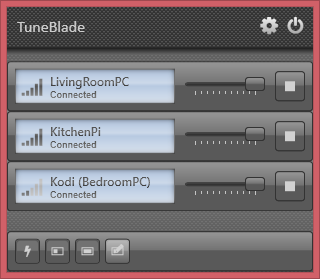Welcome to what is possibly the concluding post in my Raspberry Whole Home
Audio Project series of posts… or possibly not.
At the start of this journey I had a plan to install mopidy on one of my Raspberry Pis and use pulse
audio to stream the output to the others. Along the way I ran into some challenges
stemming from me buying the cheapest peripherals I could (and subsequently needing
to upgrade the WiFi adapters and power cables I first bought to better ones),
and my vision evolved as things progressed.
Instead of using mopidy, I switched to installing Kodi on each of the Pis thanks to the OpenElec linux distribution that’s available for
several types of hardware, the Pi included.

Kodi, as a full-blown media centre system, might seem like a
bit of an odd choice for a headless device (i.e. something with no attached
display), but it’s the right choice for me for a couple of reasons.
- I already have it installed on a couple of PCs
in the house, attached to the TVs in the living room and the bedroom - I already have a remote
control app for it on my phone - There are plugins for a bunch of stuff, such as this one for my favourite music streaming service. Well written
plugins integrate perfectly with the system, and the remote control app. - It has built-in support for acting as an airplay
receiver
For me, these things combine to provide me with the best of
both worlds. If I just want to play music from my library or from an internet
streaming service on one set of speakers, then I fire up the remote app and
target the particular device I want to output from.
If I want to play the same thing on several (or all) the
devices at the same time, then I fire up TuneBlade
on my laptop and any sounds that would usually come out of its speakers get
redirected to all the airplay receivers.

When it works, it’s glorious. Having the same music playing
in sync on all the speakers in the apartment is awesome.
The problem is that it doesn’t always work. TuneBlade
includes a setting that lets you set how much of a buffer you want. If you set
it too high the devices won’t synchronize because it will take a slightly
different amount of time to fill the buffer on each of them. I have it set to
zero, which works amazingly well most of the time but leaves me especially
prone to blips in network connectivity and bandwidth. When these occur, things
get out of sync (which sounds terrible, because each set of speakers is not all
that far away from its neighbours), and it can’t seem to automatically recover –
I have to manually disconnect and reconnect the affected player to get it back
in sync with its peers.
The bottom line then is that my setup is good, but not
perfect. It’s no Sonos.
The search for a perfect system will likely continue, but
for the time being I’m pretty content. I spent less than $100, and I have a
setup that would have cost me $5,000 from them.